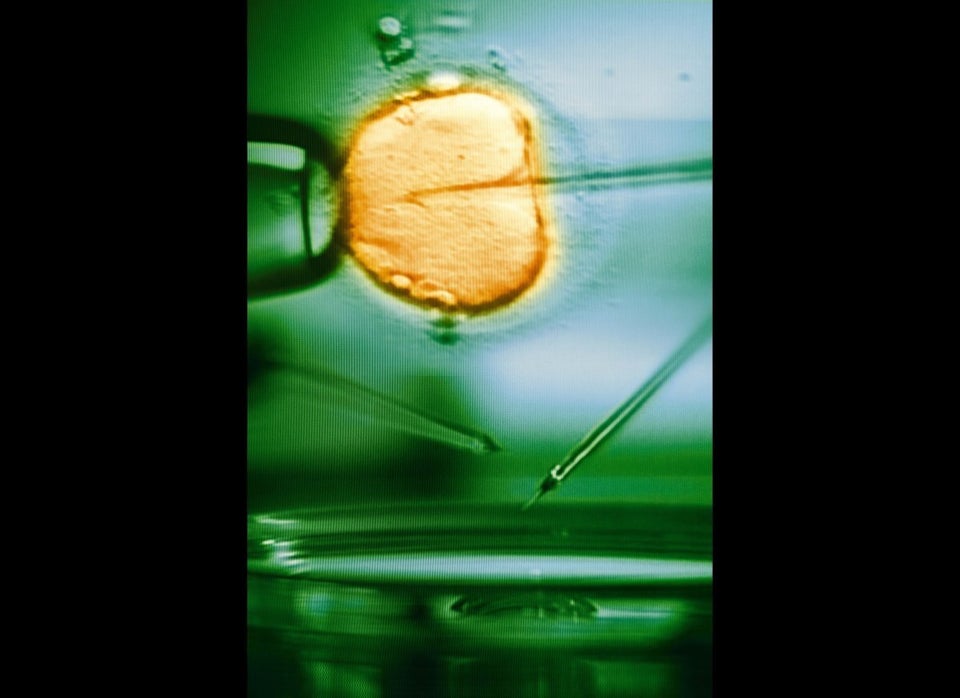Five million IVF babies have been born since the era of assisted reproduction dawned in 1978, it has been calculated.
Experts based the estimate on worldwide figures for In-Vitro Fertilisation (IVF) treatment cycles up to 2008.
The emerging pattern was extended to gauge how many more treatments took place over the next three years.
The cumulative number of IVF births in total stood at 4.6m last year and is now believed to have reached five million.

Passing the five million milestone represented a "moment of pride" for fertility scientists, according to a British member of the team that brought the first IVF baby into the world.
SEE ALSO:
When Louise Brown was born at Oldham General Hospital on July 25, 1978, it caused a sensation.
The birth of a "test tube baby", as Louise was described in the media at the time, was hugely controversial and sparked an intense ethical debate.
But British experts today pointed out that IVF had now become routine in many parts of the world.
Dr Allan Pacey, chair of the British Fertility Society and senior lecturer in andrology at the University of Sheffield, said: "Everyone expected the proportion of IVF treatment cycles to plateau, but it hasn't. Year-on-year we have seen what is effectively a linear rise.
"I think it's more than just older women relying on IVF; I think it's more about accessibility, social acceptability, funding issues, and to an extent that IVF is part of the mainstream now."
Colleague Stuart Lavery, consultant gynaecologist and director of IVF at Hammersmith Hospital in London, said: "IVF is something couples are no longer ashamed of. The profile is becoming more acceptable and it's also becoming more successful."
OTHER IVF NEWS:
The five million figure was announced today at the annual meeting of the European Society of Human Reproduction and Embryology (Eshre) taking place in Istanbul, Turkey.
Dr David Adamson, chair of the International Committee for Monitoring Assisted Reproductive Technologies (ICMART), which made the calculation, said: "Millions of families with children have been created, thereby reducing the burden of infertility.
"The technology has improved greatly over the years to increase pregnancy rates. The babies are as healthy as those from other infertile patients who conceive spontaneously. The technology is available globally in many different countries. IVF is firmly established now in the mainstream of medicine."
Dr Simon Fishel, managing director of clinic chain Care Fertility UK and a member of the Cambridge team responsible for the birth of Louise Brown, said: "I remember well the time of Louise's birth, and also transferring the embryo that became her sister, both of whom are now mums in their own right.
"The five million milestone not only justifies all the legal and moral battles, the ethical debates and hard-fought social approval, it is also a testament to the great scientists and doctors who have worked so hard to improve the treatment of patients, and to the patients themselves who have put their faith in us.
"It is a moment of pride for our unique branch of medical science, and a point to reflect on how we must continue to fight for our patients where there still remain barriers to treatment."
Take a look at these famous faces who have spoken out about their fertility problems and IVF journeys...
Other ICMART data show that each year, around 1.5m assisted reproduction treatment cycles are performed globally, delivering some 350,000 babies.
Europe is the most active IVF region in the world, with the US and Japan topping the list of individual countries.
In 2009 the UK had an IVF rate of 879 treatment cycles per million members of the population per year.
IVF take-up is much greater in Denmark and Belgium, with rates of 2,726 cycles per million and 2,562 cycles per million respectively.
Success rates from a single "fresh" IVF treatment cycle appear to have stabilised at around 32% per embryo transfer, the Eshre meeting was told.
Mr Lavery stressed that despite the success of IVF it should never be regarded as an "insurance policy" for women who want to delay pregnancy as long as possible.
IVF is not very effective for women some way past their reproductive prime, he said.
"We need to get the message across that people cannot necessarily rely on it as the answer to issues later in life," said Mr Lavery. "Although there are things we can do to greatly improve success rates, the increments are small."
SEE ALSO:
A continuing trend towards fewer embryos being transferred to a woman's womb after IVF has greatly reduced the risk of multiple births, the meeting was told.
In 2009 the proportion of IVF triplets in Europe had fallen to less than 1%, and for the first time the twin birth rate was below 20%.
Traditional IVF involves mixing sperm and eggs in a laboratory Petri dish. But a more recent technique, Intra-Cytoplasmic Sperm Injection (ICSI), now accounts for the majority of treatment cycles worldwide.
ICSI involves injecting a sperm directly into an egg. It has as good a success rate as traditional IVF, but carries a small increased risk of birth defects.
Some countries have high rates of ICSI, and in Turkey it accounts for more than 70% of all IVF treatments.
In the UK, where roughly equal numbers of ICSI and traditional IVF treatments are performed, the procedure is only supposed to be used in specific circumstances. It is most often employed in cases of male infertility.
Dr Pacey said: "I really worry about the inappropriate use of ICSI, given what we know about the risks. Personally, I think it's a worry that ICSI has overtaken (traditional) IVF."

